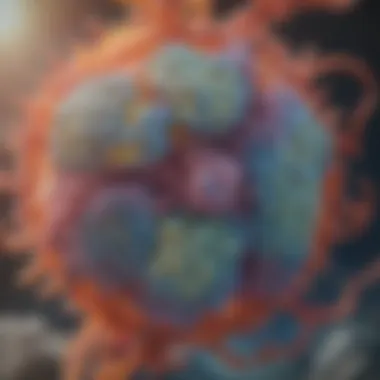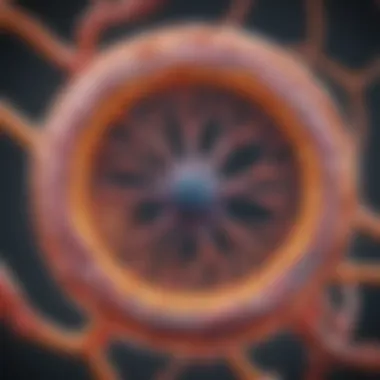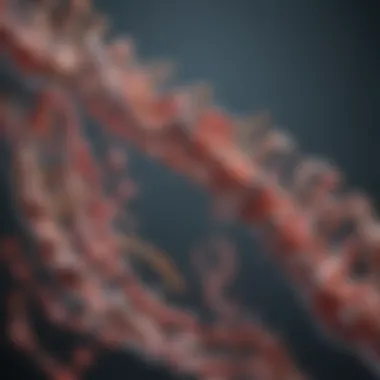Understanding Protein Synthesis Locations in Cells


Intro
Protein synthesis is a fundamental process occurring in all living cells, playing a vital role in the growth and maintenance of an organism. Proteins serve as the building blocks of life, involved in nearly every cellular function ranging from enzyme activity to cell signaling. Understanding where protein synthesis takes place is crucial for grasping the complexities of cellular biology.
This article will explore the intricate mechanisms of protein synthesis, focusing on specific organelles, including ribosomes, the endoplasmic reticulum, and the nucleus. Each of these components contributes uniquely to the overall process. Moreover, this discussion will shed light on recent findings and advances in the field, emphasizing the significance of protein synthesis in both health and disease contexts.
Key Concepts
Definition of the Main Idea
At its core, protein synthesis involves two primary processes: transcription and translation. Transcription occurs in the nucleus where the genetic information encoded in DNA is copied into messenger RNA (mRNA). This mRNA then travels to the cytoplasm, where it undergoes translation. During translation, ribosomes read the mRNA sequence, facilitating the assembly of amino acids into a polypeptide chain, which ultimately folds into a functional protein.
Overview of Scientific Principles
The protein synthesis process underscores several important principles:
- Central Dogma of Molecular Biology: This principle states that information flows from DNA to RNA to protein. It is a foundational concept in genetics, emphasizing how genetic information is expressed.
- Role of Ribosomes: Ribosomes, often termed the "molecular machines" of the cell, are critical for translating mRNA into protein. They facilitate the binding of tRNA (transfer RNA), which carries the appropriate amino acids to the growing polypeptide chain.
- Endoplasmic Reticulum's Functionality: After synthesis, proteins may enter the rough endoplasmic reticulum, where they undergo folding and modification, crucial for their proper functionality.
"Understanding protein synthesis opens the door to insights about how cells function, adapt, and respond to their environment."
"Understanding protein synthesis opens the door to insights about how cells function, adapt, and respond to their environment."
Current Research Trends
Recent Studies and Findings
Research in the field of protein synthesis is continuously evolving. Recent studies have focused on the efficiency of translation and its regulation, particularly how cells manage to allocate resources effectively to produce proteins in response to various stimuli.
Significant Breakthroughs in the Field
Innovations such as gene-editing technologies and high-throughput sequencing have significantly advanced our understanding of protein synthesis's role in health and disease. For instance, breakthroughs in understanding how misfolded proteins can lead to diseases like Alzheimer's have opened new avenues for therapeutic approaches.
In summary, protein synthesis is a complex yet fascinating process integral to cellular life. A granular understanding of where and how this occurs reveals much about living organisms and their vulnerabilities, thereby benefiting fields such as medicine and biotechnology.
Prolusion to Protein Synthesis
Protein synthesis is a fundamental biological process that plays a crucial role in the functioning and complexity of living organisms. Understanding this topic is essential, as it covers everything from genetic information to protein formation, thereby linking the fields of molecular biology, genetics, and biochemistry.
This section delves into the mechanics of how proteins are produced within the cell. Proteins are vital for almost all cellular functions. They serve as enzymes, structural components, and signaling molecules, thus dictating the overall physiology of the organism. The synthesis of proteins follows a highly regulated sequence that ensures the accurate expression of genes. Much of this process occurs in specific cellular locations, making it crucial to comprehend where and how these events unfold.
By exploring protein synthesis, readers can appreciate the intricacies involved in the translation of genetic codes into functional proteins. It underscores the significance of ribosomes, the endoplasmic reticulum, and the nucleus, each of which contributes uniquely to this vital process. An in-depth understanding will also highlight how disruptions in protein synthesis can lead to various diseases and affect overall health.
Defining Protein Synthesis
Protein synthesis refers to the intricate process by which cells harness genetic information to create proteins. This two-phase process includes transcription and translation, where DNA is first transcribed into messenger RNA (mRNA), which is then translated into a polypeptide chain. This chain folds into a functional protein that can assist in various biological tasks.
Both phases of protein synthesis are tightly regulated and coordinated. Transcription occurs in the nucleus and involves RNA polymerase synthesizing mRNA from a DNA template. Then, the mRNA exits the nucleus and enters the cytoplasm, where ribosomes facilitate the translation phase. Here, transfer RNA (tRNA) matches amino acids to the codons on the mRNA strand, ultimately forming a polypeptide chain.
Importance of Proteins in Biological Systems


Proteins are often referred to as the workhorses of the cell due to their diverse roles and functions. Each protein has its unique function based on its structure, which is determined by its amino acid sequence. Here are some key roles proteins play in biological systems:
- Catalysis: Enzymes are proteins that speed up biochemical reactions, making them essential for metabolism.
- Transport: Hemoglobin, for instance, transports oxygen in the blood, while membrane proteins facilitate transport across cell membranes.
- Structural Components: Proteins like collagen provide structural support in tissues, contributing to the body's shape and resilience.
- Signaling: Proteins are involved in cell signaling pathways, transmitting information that regulates cellular activities and responses.
- Defense: Antibodies are produced by the immune system to identify and neutralize pathogens.
In summary, proteins are indispensable to life, with their synthesis being a coordinated and regulated process. Understanding where and how proteins are synthesized provides insight into cellular functions and the maintenance of health.
Key Locations of Protein Synthesis
The process of protein synthesis is critical for all forms of life. Understanding the key locations where this process occurs helps illuminate how cells operate. Each location plays a unique role in determining the effectiveness and efficiency of protein production. Specifically, ribosomes, the endoplasmic reticulum, and the nucleus are the primary sites where various stages of protein synthesis take place. Their interaction leads to the translation of genetic information into functional proteins, which ultimately support cellular functions.
The Ribosome as the Site of Translation
Ribosomes are integral to the translation phase of protein synthesis. They are often described as the "machines" that decode mRNA sequences into amino acids. Ribosomes can be found both free in the cytosol and attached to the rough endoplasmic reticulum. This dual presence indicates their versatile role in producing proteins that function either within the cell or are secreted outside.
When a ribosome encounters an mRNA strand, it reads the sequence of codons, which correspond to specific amino acids. The ribosome facilitates the binding of transfer RNA (tRNA) molecules, each carrying an amino acid. As the ribosome moves along the mRNA strand, it catalyzes the formation of peptide bonds between the amino acids, gradually building a polypeptide chain.
Key Points about Ribosomes:
- They are composed of ribosomal RNA (rRNA) and proteins.
- Their structure enables efficient binding of tRNA and mRNA.
- Regulation of ribosomal activity can influence protein synthesis rates.
Role of the Endoplasmic Reticulum
The endoplasmic reticulum (ER) serves as a crucial collaborator in the protein synthesis journey. It exists in two forms: rough and smooth. The rough ER is studded with ribosomes, making it the primary site for the synthesis of proteins destined for the cell membrane or secretion. It modifies these proteins through glycosylation, which is the addition of sugar groups, thus preparing them for their eventual functions.
In contrast, the smooth ER does not have ribosomes and is involved primarily in lipid synthesis and detoxification processes. While it does not directly participate in protein synthesis, the interconnectedness of the ER with ribosomes aids in the folding and maturation of newly synthesized proteins. Here, misfolded proteins can be identified and targeted for degradation, ensuring that only correctly formed proteins proceed in the cellular pathway.
The Nucleus and mRNA Formation
The nucleus is often referred to as the control center of the cell, since it houses the genetic material. Protein synthesis begins with transcription, a process that transcribes DNA into messenger RNA (mRNA). This mRNA carries the genetic instructions required for protein synthesis out of the nucleus and into the cytoplasm.
Inside the nucleus, enzymes called RNA polymerases bind to DNA and synthesize a complementary RNA strand. Once this mRNA strand is formed, it undergoes several modifications, including capping and polyadenylation. These modifications are crucial for mRNA stability, export from the nucleus, and translation efficiency.
"The orchestration of transcription and translation in distinct cellular locations is fundamental for gene expression and protein function."
"The orchestration of transcription and translation in distinct cellular locations is fundamental for gene expression and protein function."
Mechanisms of Protein Synthesis
The mechanisms of protein synthesis are crucial to understanding how cells produce proteins. This process involves several steps, primarily transcription and translation, which convert the genetic information stored in DNA into functional proteins. Each stage has its own specific role and importance, creating a sophisticated system necessary for life.
Transcription: From DNA to mRNA
Transcription is the first step in protein synthesis, where DNA is used as a template to synthesize messenger RNA (mRNA). This process takes place in the nucleus of eukaryotic cells. RNA polymerase binds to the promoter region of a gene and unwinds the DNA strands. As the RNA polymerase moves along the DNA, it assembles nucleotides into a single strand of mRNA, which is complementary to the DNA template.
Key points in transcription include:
- Template strand: Only one of the two DNA strands is typically used as the template for mRNA synthesis.
- RNA polymerase: The key enzyme that facilitates the formation of mRNA.
- Modification: After synthesis, the mRNA undergoes modifications, including the addition of a 5' cap and a poly-A tail, which are essential for stability and translation.
Once transcription is complete, the mRNA exits the nucleus through nuclear pores and enters the cytoplasm, where translation occurs.
Translation: The Role of tRNA


Translation is the process through which ribosomes synthesize proteins based on the sequence of codons in mRNA. Transfer RNA (tRNA) plays a critical role during this phase. Each tRNA molecule is attached to a specific amino acid and possesses an anticodon that can base-pair with the corresponding codon on the mRNA strand.
The translation process involves several key stages:
- Initiation: The ribosome assembles around the mRNA with the tRNA initiating at the start codon, usually AUG.
- Elongation: tRNA molecules continue to bring amino acids to the ribosome, forming a growing polypeptide chain as the ribosome moves along the mRNA.
- Termination: The process ends when a stop codon is reached, prompting the release of the completed protein.
The accuracy of translation is paramount, as any errors can result in malfunctioning proteins, leading to potential health issues.
Post-Translational Modifications
After translation, proteins often undergo post-translational modifications, which are alterations that affect the protein’s structure and function. These modifications are essential for regulating protein activity and stability. Key types of post-translational modifications include:
- Phosphorylation: The addition of phosphate groups, which can activate or deactivate enzymes.
- Glycosylation: The attachment of sugar molecules that can influence protein folding and stability.
- Ubiquitination: The tagging of proteins for degradation, helping to regulate protein levels within the cell.
These modifications can profoundly impact a protein's function, affecting everything from its location in the cell to its interaction with other molecules.
Types of Ribosomes
Understanding the types of ribosomes is crucial in the context of protein synthesis. Ribosomes are the cellular machinery responsible for translating genetic information into proteins. Their classification into free ribosomes and bound ribosomes reflects their distinct functions and locations within the cell.
Free Ribosomes vs. Bound Ribosomes
Free ribosomes float freely in the cytoplasm, synthesizing proteins that typically function within the cytosol. These proteins are often involved in cell metabolism and signaling pathways. In contrast, bound ribosomes are attached to the endoplasmic reticulum, forming what is known as the rough endoplasmic reticulum (RER). The proteins synthesized by bound ribosomes are usually destined for secretion, incorporation into the cell membrane, or for use in lysosomes.
Key differences between free and bound ribosomes include:
- Location: Free ribosomes are found in the cytoplasm, while bound ribosomes are on the RER.
- Function: Free ribosomes generally synthesize cytosolic proteins, whereas bound ribosomes make secretory and membrane proteins.
This distinction is essential for understanding how cells direct proteins to their appropriate locations. The type of ribosome engaged affects not only the destination of the protein but also its final function in the cellular context.
Polyribosomes and Their Function
Polyribosomes, or polysomes, are clusters of ribosomes simultaneously translating a single mRNA strand. This arrangement allows for multiple copies of a protein to be synthesized efficiently from one mRNA molecule. When multiple ribosomes are engaged, the protein production process becomes faster and more efficient.
Advantages of polyribosomes include:
- Increased efficiency: More protein is produced in a shorter time.
- Resource management: The cell can optimize its resources by utilizing mRNA effectively.
Polyribosomes play a vital role in rapidly producing proteins when cells face high demands, such as during growth or response to stimuli. They highlight the intricate level of regulation in protein synthesis, ensuring that cells can adapt to varying biological needs.
"Ribosomes are indispensable for life, managing a complex interplay between synthesis and the functional needs of the cell."
"Ribosomes are indispensable for life, managing a complex interplay between synthesis and the functional needs of the cell."
Gene Expression and Regulation
Gene expression is the process by which information from a gene is used to synthesize a functional gene product, usually proteins. Understanding gene expression and its regulation is crucial due to its impact on various cellular functions and overall organismal biology. Gene regulation determines when and how genes are activated or silenced, thereby influencing protein production, cell behavior, and the response to environmental stimuli. This aspect is essential in studies of developmental biology, genetics, and disease pathogenesis.
In the context of protein synthesis, gene expression regulation ensures that the right proteins are produced at the right times and in appropriate amounts. This regulation has implications in health and disease, including cancer, where misregulation can lead to uncontrolled cell division.


The Role of Promoters and Enhancers
Promoters are DNA sequences located at the beginning of a gene. They serve as the initial site for RNA polymerase binding, initiating transcription. Enhancers are regulatory elements that can be located far from the actual gene they regulate. They increase the likelihood that transcription will occur. The interaction between promoters and enhancers is pivotal for determining the transcriptional output of a gene.
Factors like transcription factors can bind to these enhancers and promoters, influencing the transcription process. Different cell types often express unique sets of promoters and enhancers, contributing to tissue specificity of gene expression. This specificity is vital for the proper functioning of complex organisms.
"Gene expression regulation is a cornerstone of biological control, impacting development, metabolism, and response to stimuli."
"Gene expression regulation is a cornerstone of biological control, impacting development, metabolism, and response to stimuli."
Regulatory Proteins and Their Impact
Regulatory proteins play a significant role in gene expression. They include transcription factors, repressors, and co-activators, which can either enhance or inhibit transcription. Transcription factors bind to specific DNA sequences in the promoter and enhancer regions, modulating RNA polymerase activity. This regulation determines how much mRNA is synthesized, directly influencing protein levels inside the cell.
Key points regarding regulatory proteins:
- They can be influenced by external signals, allowing cells to adapt to environmental changes.
- Mutations in genes encoding these proteins can lead to diseases, including various cancers.
- Understandingtheir function provides insights into therapeutic targets for drug design.
The dynamics of gene expression and regulation are complex. Many factors interact in this finely-tuned process, underscoring its relevance in cellular biology. This area continues to be a primary focus of research, with implications for biotechnology and medicine.
Implications of Protein Synthesis
Protein synthesis is a cornerstone of life, with significant implications for both health and industry. Understanding where protein synthesis occurs in the cell provides insight into its fundamental role in biological systems. Each organelle involved brings distinct advantages that contribute to the overall process of protein development.
Health and Disease Associations
Proteins are crucial macromolecules that support a wide variety of functions in the body. At a cellular level, disturbances in protein synthesis can lead to serious health issues. For example:
- Genetic Disorders: Mutations in genes that encode for proteins can result in diseases like cystic fibrosis or sickle cell anemia. These conditions occur when the proteins produced are either malfunctioning or absent entirely.
- Cancer: Abnormal protein synthesis can promote cancer. Oncogenes may cause uncontrolled cell growth, leading to tumor formation.
- Metabolic Disorders: Proteins that serve as enzymes may be insufficiently produced or function improperly, affecting metabolism and leading to conditions like diabetes or phenylketonuria.
In contrast, understanding protein synthesis allows for the development of targeted therapies. Treatments that focus on correcting faulty synthesis mechanisms provide pathways toward better healthcare outcomes.
Biotechnological Applications
The implications of protein synthesis extend beyond biology into various fields of biotechnology. Advances in this area allow us to harness the potential of proteins in diverse applications:
- Recombinant Proteins: The production of proteins in laboratory settings through genetic engineering has led to breakthroughs in medicine. Humulin, the first recombinant insulin, has transformed diabetes management.
- Vaccines: Many vaccines utilize proteins to stimulate an immune response. Recombinant protein vaccines help combat infectious diseases by introducing harmless protein fragments of pathogens.
- Biopharmaceuticals: Production of monoclonal antibodies and therapeutic proteins has surged. Understanding protein synthesis enables the design of complex drugs tailored to fight specific diseases.
The implications of protein synthesis are far-reaching, influencing health outcomes and biotechnological progress. The ongoing research into the modulation of protein synthesis mechanisms may open new avenues for innovations in healthcare and industry.
Ending
In summarizing the topic of protein synthesis, it is essential to appreciate the intricate processes involved and the critical locations where these events occur. This article has provided an exhaustive overview of how proteins are synthesized in cells, emphasizing the roles of organelles such as the ribosome, endoplasmic reticulum, and nucleus. Each component plays a unique role that facilitates the complex journey from genetic information in DNA to functional proteins essential for life.
Summary of Key Points
- Protein synthesis occurs mainly in the ribosomes, where translation of mRNA takes place.
- The endoplasmic reticulum further processes and transports proteins after initial synthesis.
- The nucleus is the site for transcription, where mRNA is formed from DNA.
- The involvement of multiple cellular components highlights the collaborative nature of this process.
Understanding these aspects is crucial for students, researchers, and professionals, as they navigate fields related to molecular biology, genetics, and biotechnology. The research and applications stemming from protein synthesis can lead to breakthroughs in health, disease treatment, and biotechnology developments that influence medical science and therapeutic strategies.
Future Directions in Protein Synthesis Research
Research in protein synthesis continues to evolve, with several exciting prospects for the future. Some key areas of focus may include:
- Enhanced Understanding of Ribosomal Dynamics: Investigating how ribosomes assemble and function can unveil new mechanisms controlling protein production.
- Artificial Protein Synthesis Techniques: Developing synthetic biology approaches that enable the creation of novel proteins for therapeutic uses.
- Effects of Modifications on Functionality: Studying post-translational modifications in greater detail to comprehend how they affect protein function and interactions.
- Protein Misfolding and Disease: Exploring the relationship between protein synthesis errors and diseases such as Alzheimer's or other neurodegenerative disorders.
Overall, the future of protein synthesis research promises to deepen our understanding of cellular functions and could yield novel applications in medicine and biotechnology.







